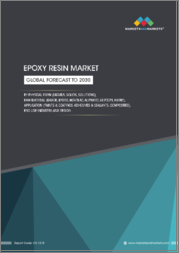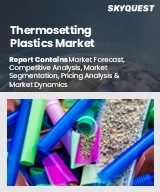
|
시장보고서
상품코드
1347129
세계의 에폭시 복합 수지 시장(2016-2030년) : 섬유 종류별, 용도별(자동차 부품, 접착제와 실란트, 해양 시스템, 터빈 블레이드, 기타), 최종사용자 산업별, 지역별 기회 및 예측Epoxy Composite Resin Market Assessment, By Fiber Type, By Application (Automobiles Components, Adhesives & Sealants, Marine Systems, Turbine Blades, and Others), By End-use Industry, By Region, Opportunities, and Forecast, 2016-2030F |
||||||
에폭시 복합 수지 시장 규모는 2022년 86억 달러에서 예측 기간 동안 6.2%의 CAGR을 기록하며 2030년에는 139억 달러 규모로 성장할 것으로 예상됩니다.
자동차 관련 제조 활동의 증가와 항공우주 산업에서 우수한 접합 재료에 대한 수요 증가가 이 시장을 이끄는 주요 요인입니다.
새로운 자동차 장비 개발에 대한 투자 증가, 전기자동차에 대한 수요 증가 등이 세계 자동차 산업의 성장을 가속화하고 있습니다. 또한, 상업용 건물의 바닥 면적 확대에 대한 수요 증가와 인프라 개발 프로젝트의 증가는 아시아태평양, 북미 및 기타 지역의 건축 및 건설 활동의 성장을 촉진하고 있습니다. 자동차 제조의 증가와 건축 및 건설 활동의 증가는 마모 및 부식에 대한 우수한 내성, 높은 난연성 및 효율적인 경화제 특성을 보장할 수 있는 에폭시 복합 수지에 대한 수요를 촉진하여 시장 성장을 촉진하고 있습니다.
반응성 프리폴리머의 일종인 에폭시 복합 수지를 제공하는 주요 업체들은 업그레이드된 제품 제공을 늘리기 위해 신제품 혁신에 투자하고 있습니다. 이처럼 다양한 최종사용자 산업에서 경화제 역할을 하는 신제품의 채택이 증가함에 따라 에폭시 복합 수지 취급 기업의 매출 점유율이 상승하여 시장 성장에 기여하고 있습니다.
세계 에폭시 복합 수지 시장을 조사했으며, 시장 정의와 개요, 시장 규모 추이 및 예측, 각종 부문별·지역별 상세 분석, 산업 구조, 시장 성장에 영향을 미치는 요인 분석, 사례 연구, 경쟁 상황, 주요 기업 개요 등의 정보를 정리하여 전해드립니다.
목차
제1장 조사 방법
제2장 프로젝트 범위와 정의
제3장 COVID-19가 에폭시 복합 수지 시장에 미치는 영향
제4장 러시아·우크라이나 전쟁의 영향
제5장 주요 요약
제6장 고객의 소리
- 시장 인식과 제품 정보
- 브랜드 인지도와 로열티
- 구입 결정시에 고려되는 요소
- 구입 빈도
- 구입 매체
제7장 에폭시 복합 수지 시장 전망
- 시장 규모와 예측
- 섬유 유형별
- 합성
- 유기
- 용도별
- 자동차 부품
- 접착제 및 실란트
- 해양 시스템
- 터빈 블레이드
- 기타
- 최종 이용 산업별
- 자동차
- 항공우주
- 선박·해양
- 재생에너지
- 건축·건설
- 전기·전자
- 스포츠
- 기타
- 지역별
- 북미
- 유럽
- 남미
- 아시아태평양
- 중동 및 아프리카
제8장 에폭시 복합 수지 시장 전망 : 지역별
- 북미
- 유럽
- 남미
- 아시아태평양
- 중동 및 아프리카
제9장 공급측 분석
- 제조능력 : 기업별
- 제조량 : 기업별
- 가동 효율 : 기업별
- 주요 공장 소재지
제10장 시장 매핑
- 섬유 유형별
- 용도별
- 최종 이용 산업별
- 지역별
제11장 거시적 환경·산업 구조
- 수급 분석
- 수출입 분석
- 공급망/밸류체인 분석
- PESTEL 분석
- Porter's Five Forces 분석
제12장 시장 역학
- 성장 추진요인
- 성장 억제요인(과제·제약)
제13장 주요 기업 상황
- 시장 리더 상위 5개사 경쟁 매트릭스
- 시장 리더 상위 5개사 시장 매출 분석
- M&A(해당되는 경우)
- SWOT 분석(참여 5개사)
- 특허 분석(해당되는 경우)
제14장 가격 분석
제15장 사례 연구
제16장 주요 기업 전망
- Toray Industries, Inc.
- Huntsman International LLC.
- Copps Industries
- Hexcel Corporation
- Solvay
- Olin Corporation.
- PARK AEROSPACE CORP.
- Westlake Epoxy.
- Polytec Elastoform GmbH
- Final Advanced Materials
제16장 전략적 제안
제17장 당사 소개와 면책사항
ksm 23.09.22Epoxy Composite Resin Market size was valued at USD 8.6 billion in 2022, which is expected to grow to USD 13.9 billion in 2030 with a CAGR of 6.2% during the forecast period between 2023 and 2030. The increasing production activities related to automotive vehicles at the global level and the rising demand for superior bonding materials in the aerospace industry are the prominent aspects driving the epoxy composite resin market.
The increasing investment in developing new automotive facilities, rising demand for electric vehicles, and others are accelerating the automotive industry's growth at the global level. In addition, the rising demand for larger floor areas for commercial buildings, rising infrastructure development projects, and others are key trends boosting the growth of building & construction activities in various regions, including Asia-Pacific, North America, and others. Therefore, the increasing production activities for automotive vehicles and the rising building & construction activities are fuelling the demand for epoxy composite resin to ensure superior resistance against wear and corrosion, higher flame-retardant properties, and efficient curing agent properties which, in turn, is driving the market growth.
The Recent Product Innovations for the Epoxy Composite Resins
The leading industry players offering epoxy composite resin, a type of reactive prepolymer, are investing in new product innovations to increase the upgraded product offering in the global market. Thus, the revenue share of the companies dealing in epoxy composite resin is rising as the adoption of new products acting as curing agents increases in a diverse range of end-use industries, benefiting market growth.
For instance, in August 2022, Hexion Inc., a leading chemical manufacturer in the United States, introduced a new range of epoxy resin for application in SMC manufacturing of automotive composites. Thus, the recent product innovations related to epoxy composite resins equipped with updated features are driving market growth at the global level.
The Rising Automotive Production Activities
Using epoxy composite resin in automotive acts as a curing agent to minimize the weight of the finished automotive part. The advantages of reducing the weight of automobiles include minimum fuel consumption and operating costs, thereby leading to fewer emissions. The growth of the automotive industry is attributed to factors such as government subsidies for electric vehicles, increasing developments in autonomous vehicles, and others.
For instance, according to the recent statistics published by the European Automobile Manufacturers Association (ACEA), in 2021, global automotive production was 80.8 million units. In 2022, it was 85.4 million units, an increase of 5.7%. Hence, the increase in the production of automotive vehicles at the global level is boosting the demand for epoxy composite resins to ensure the lightweight structure of automobiles, which, in turn, is favouring market growth.
The Booming Aerospace Industry is Supplementing Market Growth
The epoxy composite resin is a curing agent to sustain an aircraft's strength and durability, ensuring the airliners transport more passengers and cargo at reduced fuel costs. The development of new compact aircraft, new technological innovations in the aerospace industry, and others are boosting the growth of the aerospace industry.
For instance, in 2020, the delivery of newly built aircraft by Boeing was 154 units; in 2021, it was 169 units, an increase of 9.7%. Therefore, the booming aerospace industry is fostering the demand for epoxy composite resin to ensure superior structural strength and flame-retardant properties, which, in turn, is propelling the market growth.
Development of New Wind Energy Projects
The epoxy composite resin is a type of reactive prepolymer, ideal for wind energy to secure the larger blade's size, efficient curing agent, lighter, superior flame-retardant, and others. Thus, the wind energy blades displace significant air, making wind energy highly cost-effective. The prime variables, including increasing renewable energy targets and other trends, are boosting the development of new wind energy projects.
For instance, in August 2022, Iberdrola commenced the development of the 1,400 MW East Anglia Three offshore wind farm in the United Kingdom. The project will provide electricity to 1.3 million houses in the United Kingdom in 2026. As a result, the development of new wind energy projects in various countries, including the United Kingdom, India, and others, is fostering the demand for epoxy composite resins to ensure the cost-effectiveness of wind turbine blades, which, in turn, is increasing the market growth.
Impact of COVID-19
The stringent COVID-19 protocols in 2020 significantly impacted the production of aircraft, vehicles, and others. For instance, according to the Organisation Internationale des Constructeurs d'Automobiles (OICA), in 2019, the global automotive production was 92,120,732 units, and in 2020, it was 77,650,152 units, a decline of 15.7%. Thus, the halt of automotive output led to a decline in the market's revenue growth in 2020.
However, the economic stimulus packages significantly enhanced the epoxy composite resin market growth by 2020. Likewise, in the coming years, it is anticipated the impact of the COVID-19 pandemic will be eradicated, which will boost the epoxy composite resin industry's outlook during the projected forecast period.
Impact of Russia-Ukraine War
The Russia-Ukraine war posed a bottleneck in the supply of raw materials, higher energy prices, and others. As a result, the manufacturing activities of industrial products in Russia, Ukraine, and several European countries were halted in the first half of 2022. Thus, the demand for epoxy composite resin declined in the first half of 2022 in Russia, Ukraine, Poland, and others.
For instance, in February 2022, Isuzu halted automotive production in Russia. Thus, the halt in industrial manufacturing activities due to Russia's invasion of Ukraine created a roadblock for epoxy composite resin in the first half of 2022.
Key Players Landscape and Outlook
The prominent epoxy composite resin market players include Toray Industries, Inc., Huntsman International LLC., Copps Industries, and Hexcel Corporation. These are equipped with state-of-the-art manufacturing facilities to ensure bulk product requirements as per the end-use industries' demand. The major players in the manufacturing of epoxy composite resin are investing in strategies such as new product innovation, acquisitions, and others to increase their market share in the epoxy composite resin industry.
For instance, in February 2022, Westlake Chemical Corporation, a global manufacturer of materials, acquired the epoxy business unit of Hexion Inc., a United States-based manufacturer of epoxy composite resin for USD 1.2 billion. The primary aim of acquiring Hexion Inc. was to increase the revenue growth of Westlake Chemical Corporation in the global epoxy composite resin market.
Table of Contents
1. Research Methodology
2. Project Scope & Definitions
3. Impact of COVID-19 on Epoxy Composite Resin Market
4. Impact of Russia-Ukraine War
5. Executive Summary
6. Voice of Customer
- 6.1. Market Awareness and Product Information
- 6.2. Brand Awareness and Loyalty
- 6.3. Factors Considered in Purchase Decision
- 6.3.1. Brand Name
- 6.3.2. Quality
- 6.3.3. Quantity
- 6.3.4. Price
- 6.3.5. Product Specification
- 6.3.6. Application Specification
- 6.3.7. Shelf-Life
- 6.3.8. Availability of Product
- 6.4. Frequency of Purchase
- 6.5. Medium of Purchase
7. Epoxy Composite Resin Market Outlook, 2016-2030F
- 7.1. Market Size & Forecast
- 7.1.1. By Value
- 7.1.2. By Volume
- 7.2. By Fiber Type
- 7.2.1. Synthetic
- 7.2.1.1. Glass Fiber
- 7.2.1.2. Carbon Fiber
- 7.2.1.3. Others
- 7.2.2. Organic
- 7.2.2.1. Flax
- 7.2.2.2. Jute
- 7.2.2.3. Others
- 7.2.1. Synthetic
- 7.3. By Application
- 7.3.1. Automobiles Components
- 7.3.2. Adhesives & Sealants
- 7.3.3. Marine Systems
- 7.3.4. Turbine Blades
- 7.3.5. Others
- 7.4. By End-use Industry
- 7.4.1. Automotive
- 7.4.1.1. Passenger Vehicles (PVs)
- 7.4.1.2. Light Commercial Vehicles (LCVs)
- 7.4.1.3. Heavy Commercial Vehicles (HCVs)
- 7.4.2. Aerospace
- 7.4.2.1. Passenger
- 7.4.2.2. Commercial
- 7.4.2.3. Defence
- 7.4.3. Marine
- 7.4.4. Renewable Energy
- 7.4.4.1. Wind
- 7.4.4.2. Solar
- 7.4.4.3. Others
- 7.4.5. Building & Construction
- 7.4.5.1. Residential
- 7.4.5.2. Commercial
- 7.4.5.3. Industrial
- 7.4.5.4. Infrastructure
- 7.4.6. Electrical & Electronics
- 6.4.6.1. Printed Circuit Boards
- 6.4.6.2. Semiconductor
- 6.4.6.3. High-voltage Insulators
- 6.4.6.4. Others
- 7.4.7. Sports
- 7.4.8. Others
- 7.4.1. Automotive
- 7.5. By Region
- 7.5.1. North America
- 7.5.2. Europe
- 7.5.3. South America
- 7.5.4. Asia-Pacific
- 7.5.5. Middle East and Africa
8. Epoxy Composite Resin Market Outlook, By Region, 2016-2030F
- 8.1. North America*
- 8.1.1. By Fiber Type
- 8.1.1.1. Synthetic
- 8.1.1.1.1. Glass Fiber
- 8.1.1.1.2. Carbon Fiber
- 8.1.1.1.3. Others
- 8.1.1.2. Organic
- 8.1.1.2.1. Flax
- 8.1.1.2.2. Jute
- 8.1.1.2.3. Others
- 8.1.2. By Application
- 8.1.2.1. Automobiles Components
- 8.1.2.2. Adhesives & Sealants
- 8.1.2.3. Marine Systems
- 8.1.2.4. Turbine Blades
- 8.1.2.5. Others
- 8.1.3. By End-use Industry
- 8.1.3.1. Automotive
- 8.1.3.1.1. Passenger Vehicles (PVs)
- 8.1.3.1.2. Light Commercial Vehicles (LCVs)
- 8.1.3.1.3. Heavy Commercial Vehicles (HCVs)
- 8.1.3.2. Aerospace
- 8.1.3.2.1. Passenger
- 8.1.3.2.2. Commercial
- 8.1.3.2.3. Defence
- 8.1.3.3. Marine
- 8.1.3.4. Renewable Energy
- 8.1.3.4.1. Wind
- 8.1.3.4.2. Solar
- 8.1.3.4.3. Others
- 8.1.3.5. Building & Construction
- 8.1.3.5.1. Residential
- 8.1.3.5.2. Commercial
- 8.1.3.5.3. Industrial
- 8.1.3.5.4. Infrastructure
- 8.1.3.6. Electrical & Electronics
- 8.1.3.6.1. Printed Circuit Boards
- 8.1.3.6.2. Semiconductor
- 8.1.3.6.3. High-voltage Insulators
- 8.1.3.6.4. Others
- 8.1.3.7. Sports
- 8.1.3.8. Others
- 8.1.4. United States*
- 8.1.4.1. By Fiber Type
- 8.1.4.1.1. Synthetic
- 8.1.4.1.1.1. Glass Fiber
- 8.1.4.1.1.2. Carbon Fiber
- 8.1.4.1.1.3. Others
- 8.1.4.1.2. Organic
- 8.1.4.1.2.1. Flax
- 8.1.4.1.2.2. Jute
- 8.1.4.1.2.3. Others
- 8.1.4.2. By Application
- 8.1.4.2.1. Automobiles Components
- 8.1.4.2.2. Adhesives & Sealants
- 8.1.4.2.3. Marine Systems
- 8.1.4.2.4. Turbine Blades
- 8.1.4.2.5. Others
- 8.1.4.3. By End-use Industry
- 8.1.4.3.1. Automotive
- 8.1.4.3.1.1. Passenger Vehicles (PVs)
- 8.1.4.3.1.2. Light Commercial Vehicles (LCVs)
- 8.1.4.3.1.3. Heavy Commercial Vehicles (HCVs)
- 8.1.4.3.2. Aerospace
- 8.1.4.3.2.1. Passenger
- 8.1.4.3.2.2. Commercial
- 8.1.4.3.2.3. Defence
- 8.1.4.3.3. Marine
- 8.1.4.3.4. Renewable Energy
- 8.1.4.3.4.1. Wind
- 8.1.4.3.4.2. Solar
- 8.1.4.3.4.3. Others
- 8.1.4.3.5. Building & Construction
- 8.1.4.3.5.1. Residential
- 8.1.4.3.5.2. Commercial
- 8.1.4.3.5.3. Industrial
- 8.1.4.3.5.4. Infrastructure
- 8.1.4.3.6. Electrical & Electronics
- 8.1.4.3.6.1. Printed Circuit Boards
- 8.1.4.3.6.2. Semiconductor
- 8.1.4.3.6.3. High-voltage Insulators
- 8.1.4.3.6.4. Others
- 8.1.4.3.7. Sports
- 8.1.4.3.8. Others
- 8.1.5. Canada
- 8.1.6. Mexico
- 8.1.1. By Fiber Type
All segments will be provided for all regions and countries covered:
- 8.2. Europe
- 8.2.1. Germany
- 8.2.2. France
- 8.2.3. Italy
- 8.2.4. United Kingdom
- 8.2.5. Russia
- 8.2.6. Netherlands
- 8.2.7. Spain
- 8.2.8. Turkey
- 8.2.9. Poland
- 8.3. South America
- 8.3.1. Brazil
- 8.3.2. Argentina
- 8.4. Asia-Pacific
- 8.4.1. India
- 8.4.2. China
- 8.4.3. Japan
- 8.4.4. Australia
- 8.4.5. Vietnam
- 8.4.6. South Korea
- 8.4.7. Indonesia
- 8.4.8. Philippines
- 8.5. Middle East & Africa
- 8.5.1. Saudi Arabia
- 8.5.2. UAE
- 8.5.3. South Africa
9. Supply Side Analysis
- 9.1. Capacity, By Company
- 9.2. Production, By Company
- 9.3. Operating Efficiency, By Company
- 9.4. Key Plant Locations (Up to 25)
10. Market Mapping, 2022
- 10.1. By Fiber Type
- 10.2. By Application
- 10.3. By End-use Industry
- 10.4. By Region
11. Macro Environment and Industry Structure
- 11.1. Supply Demand Analysis
- 11.2. Import Export Analysis - Volume and Value
- 11.3. Supply/Value Chain Analysis
- 11.4. PESTEL Analysis
- 11.4.1. Political Factors
- 11.4.2. Economic System
- 11.4.3. Social Implications
- 11.4.4. Technological Advancements
- 11.4.5. Environmental Impacts
- 11.4.6. Legal Compliances and Regulatory Policies (Statutory Bodies Included)
- 11.5. Porter's Five Forces Analysis
- 11.5.1. Supplier Power
- 11.5.2. Buyer Power
- 11.5.3. Substitution Threat
- 11.5.4. Threat from New Entrant
- 11.5.5. Competitive Rivalry
12. Market Dynamics
- 12.1. Growth Drivers
- 12.2. Growth Inhibitors (Challenges, Restraints)
13. Key Players Landscape
- 13.1. Competition Matrix of Top Five Market Leaders
- 13.2. Market Revenue Analysis of Top Five Market Leaders (in %, 2022)
- 13.3. Mergers and Acquisitions/Joint Ventures (If Applicable)
- 13.4. SWOT Analysis (For Five Market Players)
- 13.5. Patent Analysis (If Applicable)
14. Pricing Analysis
15. Case Studies
16. Key Players Outlook
- 15.1. Toray Industries, Inc.
- 15.1.1. Company Details
- 15.1.2. Key Management Personnel
- 15.1.3. Products & Services
- 15.1.4. Financials (As reported)
- 15.1.5. Key Market Focus & Geographical Presence
- 15.1.6. Recent Developments
- 15.2. Huntsman International LLC.
- 15.3. Copps Industries
- 15.4. Hexcel Corporation
- 15.5. Solvay
- 15.6. Olin Corporation.
- 15.7. PARK AEROSPACE CORP.
- 15.8. Westlake Epoxy.
- 15.9. Polytec Elastoform GmbH
- 15.10. Final Advanced Materials
Companies mentioned above DO NOT hold any order as per market share and can be changed as per information available during research work.



















